Singapore Fried Vermicelli, also known as Bihun Goreng, is delicious, easy to cook and quick to make in under 30 minutes. Using only simple ingredients (no chicken broth needed), it's a complete meal in itself. It's also cheap enough that some hawker centres (street food stalls) in Singapore sell it for only S$2/ US$1.50!
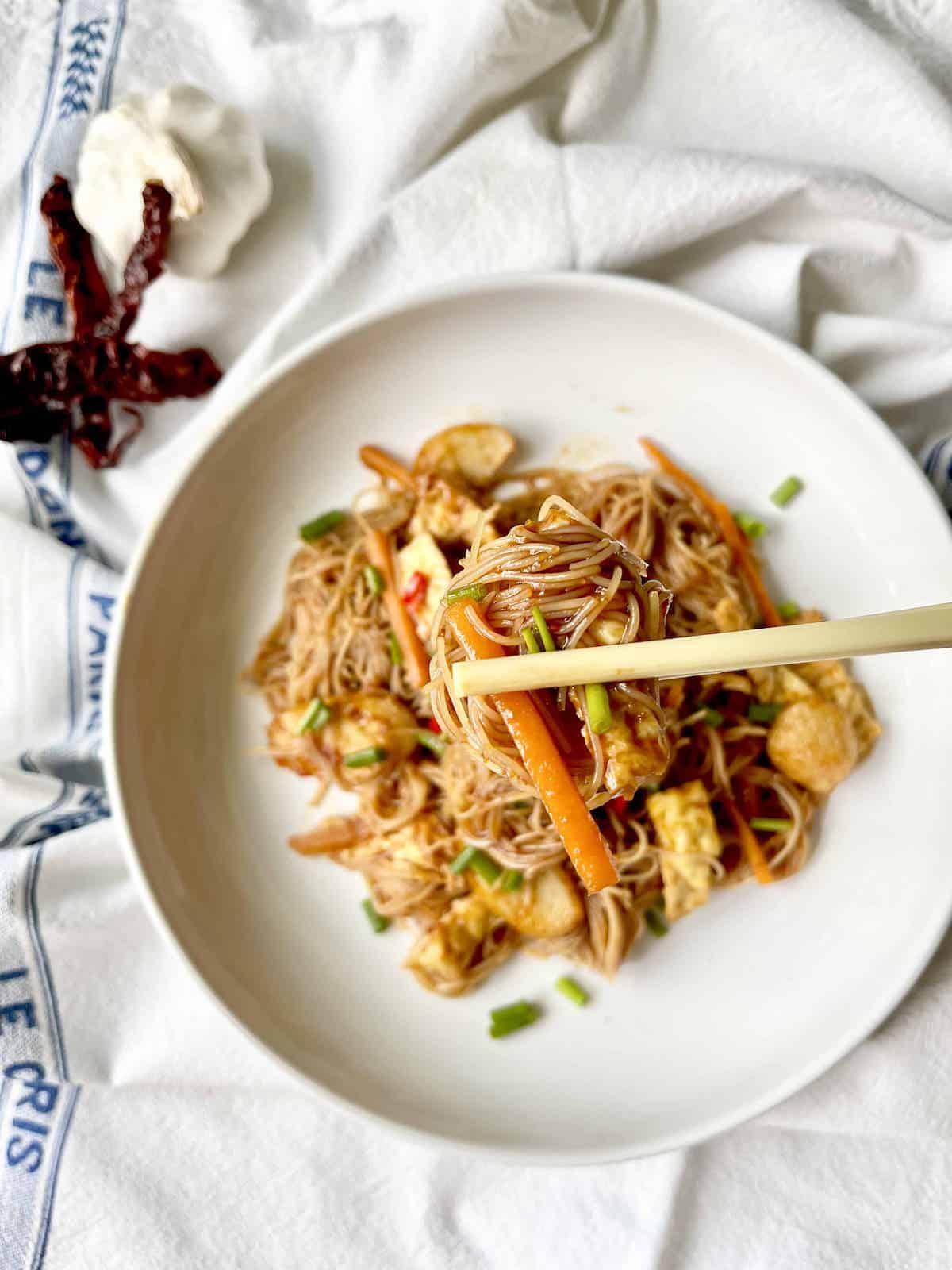
Jump to:
⭐ Why This Recipe is a Star
- Singapore Fried Vermicelli is delicious: The sauce is a little spicy (but not overpoweringly so), a little tangy, a little sweet, a little salty and altogether mouthwatering. Once you've had a bite, you'll want more!
- It's very versatile: Fried vermicelli noodles, or bihun goreng, is also easy to cook. Moreover, by making slight changes to the sauce, you can create very different dishes! It can also be anything from a humble dish (there is a version called "economic noodles" that can cost as little as $2 in Singaporean hawker centres) or a very sumptuous one if you add expensive ingredients like seafood.
Fun fact: Oh, and by the way, despite the plethora of noodle dishes in Singapore, there is no such dish as Singaporean fried noodles! Most Singaporeans experience Singapore noodles, which includes curry powder, for the 1st time in the UK!
For more authentic Singaporean vermicelli noodle dishes, try dry mee siam or mee siam with gravy.
🍜 What is Bihun?
Also known as bee hoon and mee hoon, it's a thin vermicelli noodle made from rice flour.
Much thinner than Pho or Kuay Teow, it's very popular in South East Asia (but with a chinese origin) as it cooks quickly and absorbs flavors well, whether in soup or stir-fried.
It's now very commonly used in cooking Chinese food, but according to Wikipedia, rice noodles used to be a luxury good only seen at special festivals and banquets. Probably because white rice used to be expensive due to the milling process!
If you can't find it, try 1 of these rice vermicelli substitutes.
Note: If you love this bee hoon goreng as much as I do, try these 8 longevity noodle recipes (a must-have at Chinese birthday celebrations or Chinese New Year.)
How to Use
Bihun is usually purchased in its dried form (instructions for how to cook it is in the section below.) It will expand by over 2x after soaking or blanching so you don't need that much.
Where to Buy
If you live outside of Asia, you can buy this type of thin rice noodle in the Asian market or grocery stores.
How to Store
Some bihun packets are nicely separated into portions, with 1 portion equating to 1 serving (i.e. for 1 person).
However, most brands sell the noodles in a big clump and you will need a pair of scissors to cut out the amount that you need. The rest of the bihun (uncooked) can be put in an air tight container and stored in a dark cupboard at room temperature.
Cooked bihun, on the other hand, should be kept in an airtight container in the fridge and eaten within 1-2 days.
🥘 Ingredients
These are just a few of the basic things that you will need:
- bihun: these rice vermicelli noodles are long, thin and white. However, you can also get them noodles made of red rice or brown rice for a healthier dish. For best results, don't substitute with random noodles, as egg noodles, for example, taste different as compared to vermicelli rice noodles. If you need a gluten-free alternative, mung bean thread noodles (cellophane noodles) would be a great substitute as glass noodles also absorb sauces wonderfully. (You would need to replace several of the following sauces too to make it GF.)
- aromatics: namely chilies (fresh and dried), garlic and shallot. You can use onions, preferably red, if you don't have shallots.
- tamarind: this accentuates the tomato sauce, giving the fried vermicelli its slight tang, and making your mouth water! For more ideas, click here for tamarind recipes (as well as information on this condiment) and here for plant-based tamarind dishes.
- kicap manis: you can find this sweet soy sauce in the Asian supermarkets. However, it isn't a common condiment to keep in stock if you don't cook a lot of Malay or Indonesian food, so you can always substitute with dark soy sauce mixed with a bit of palm sugar or 1 of these best kicap manis substitutes.
- light soy sauce: don't confuse this with dark soy sauce or thick soy sauce! You can substitute with fish sauce if necessary.
- oyster sauce: I recommend Lee Kum Kee, the inventor of this sauce! You can also substitute with abalone sauce if necessary
- fried fish cake: you can get this at the Asian supermarket. If not, omitting it won't change the taste of the noodles. You can also supplement with other seafood such as prawns, crab meat or abalone if cooking to impress
- Asian omelette: Western style cooking results in a golden smooth omelette whilst Asians like to have darker, "burn" marks on ours. Cut into thin long strips.
For a full list of ingredients, scroll down to the recipe card.
Optional additions
Also note that there is no limit to what you can add to these stir-fried noodles! Other common ingredients include:
- vegetables: e.g. beansprouts (tau geh), fresh shiitake mushrooms (don't use dried ones as they have a very strong flavor), sliced Chinese cabbage (napa cabbage), sliced red bell pepper and leafy greens such as bok choy and choy sum (also known as chye sim, a leafy green vegetable served with oyster sauce in a lot of Chinese restaurants) etc
- protein: e.g. tofu, SPAM cubes, sliced roast pork char siu, sliced chicken thighs (leftover roast or Hong Kong soya sauce chicken is great for this. I prefer to use dark meat as it has more fat (i.e. flavour) and doesn't dry out during stir-frying) etc
- Optional garnish: green onions (spring onions), fried dry shrimps, sliced fresh cucumber etc
Note: noodles are a common Chinese New Year (CNY) dish, so you could certainly make bihun goreng with abalone and other seafood for CNY.
Just make sure not to cut the noodles as the length symbolises long life and you don't want to shorten your life span!
🔪 Step-by-Step Instructions
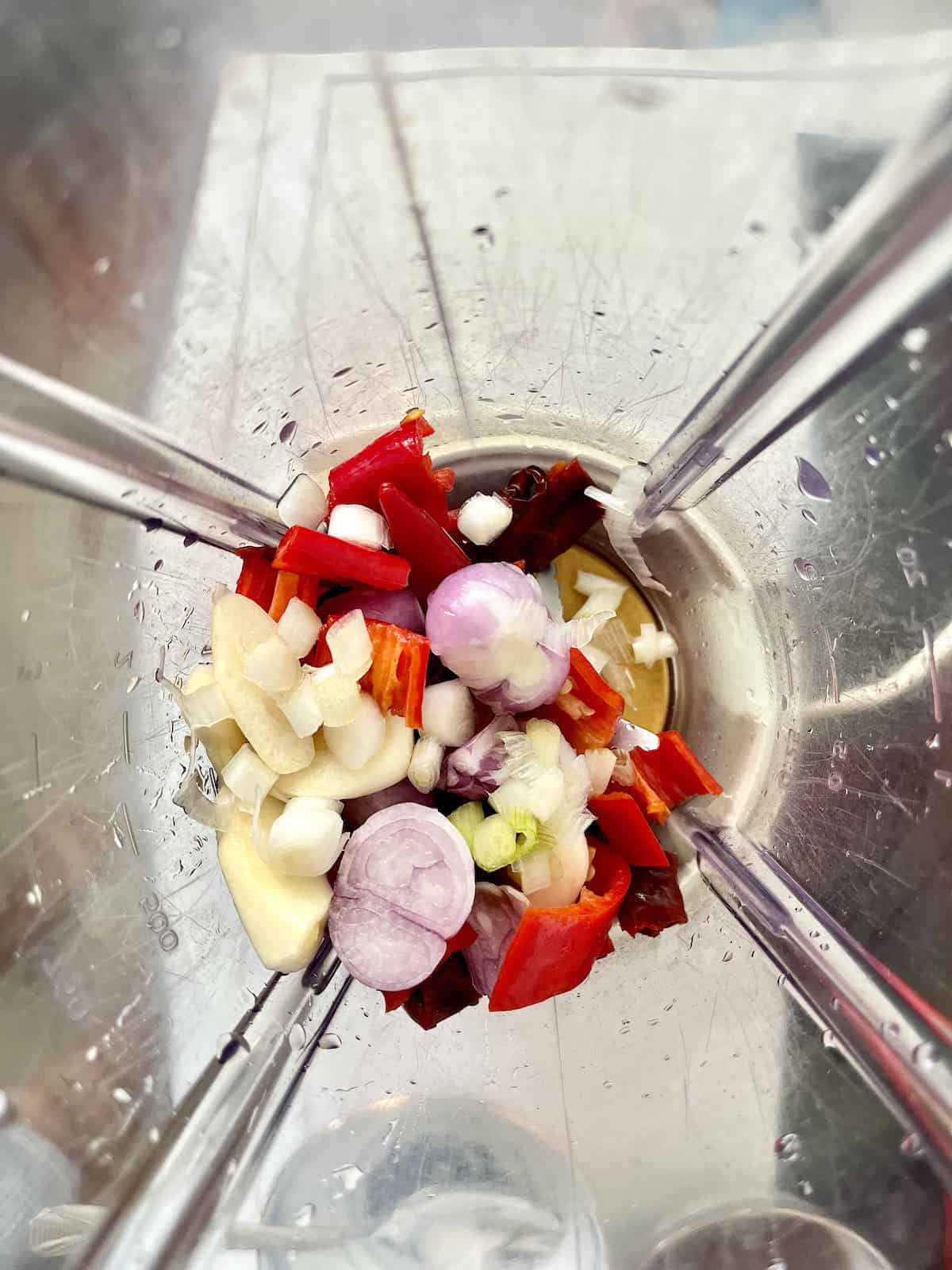
- Soften the bihun by soaking in hot water for 20-30 minutes.
- Whilst soaking, cut your fresh red and dried chillies into smaller pieces. Remove the seeds (If not, the noodles will be way too spicy!) Use gloves when handling the dried chillies and be careful not to touch your eyes or will sting!
- Add the garlic clove, shallots and cut up chillies to the blender along with the tamarind water and blitz till it becomes a watery paste.
Tip: Don't use cold water to soak the noodles or the texture will change.
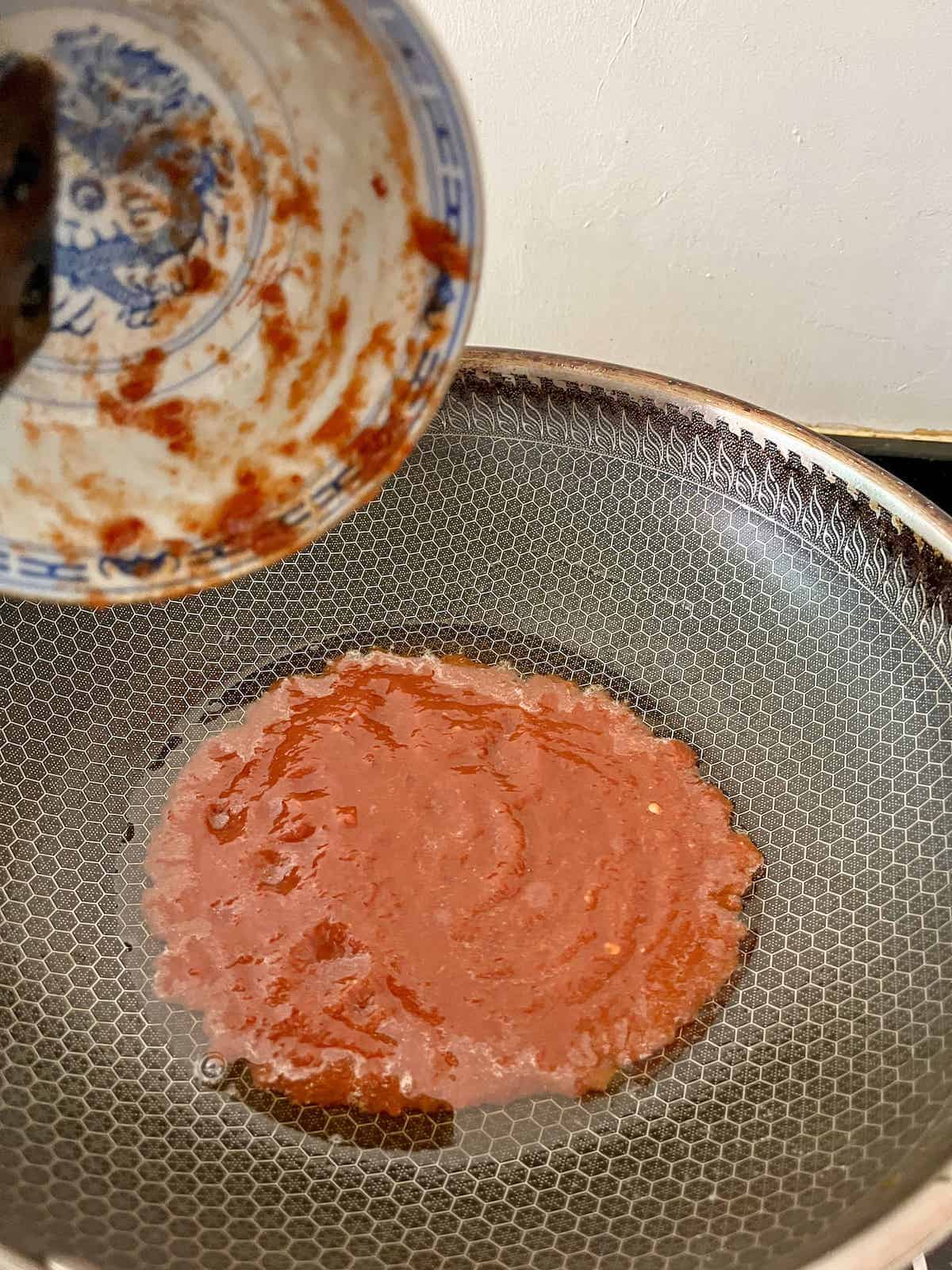
4. Heat up a large skillet (or wok) on medium-high heat and add the home rendered pork lard (or vegetable oil) to the hot wok.
5. Stir-fry the eggs, then plate and cut into strips. Using the same pan, fry the carrot strips till soft and plate with the eggs. Similarly, pan fry the fish cake slices.
6. Add more oil, followed by the blended rempah paste and stir-fry on medium heat in the same wok till it darkens and is fragrant.
Tip: I'm using a gas stove. Use medium-high heat if using an induction cooker.
Note: the photo above is the original color of the rempah. It will darken after frying.

Note: this is after stir-frying for a few minutes! You can see how the color has changed.
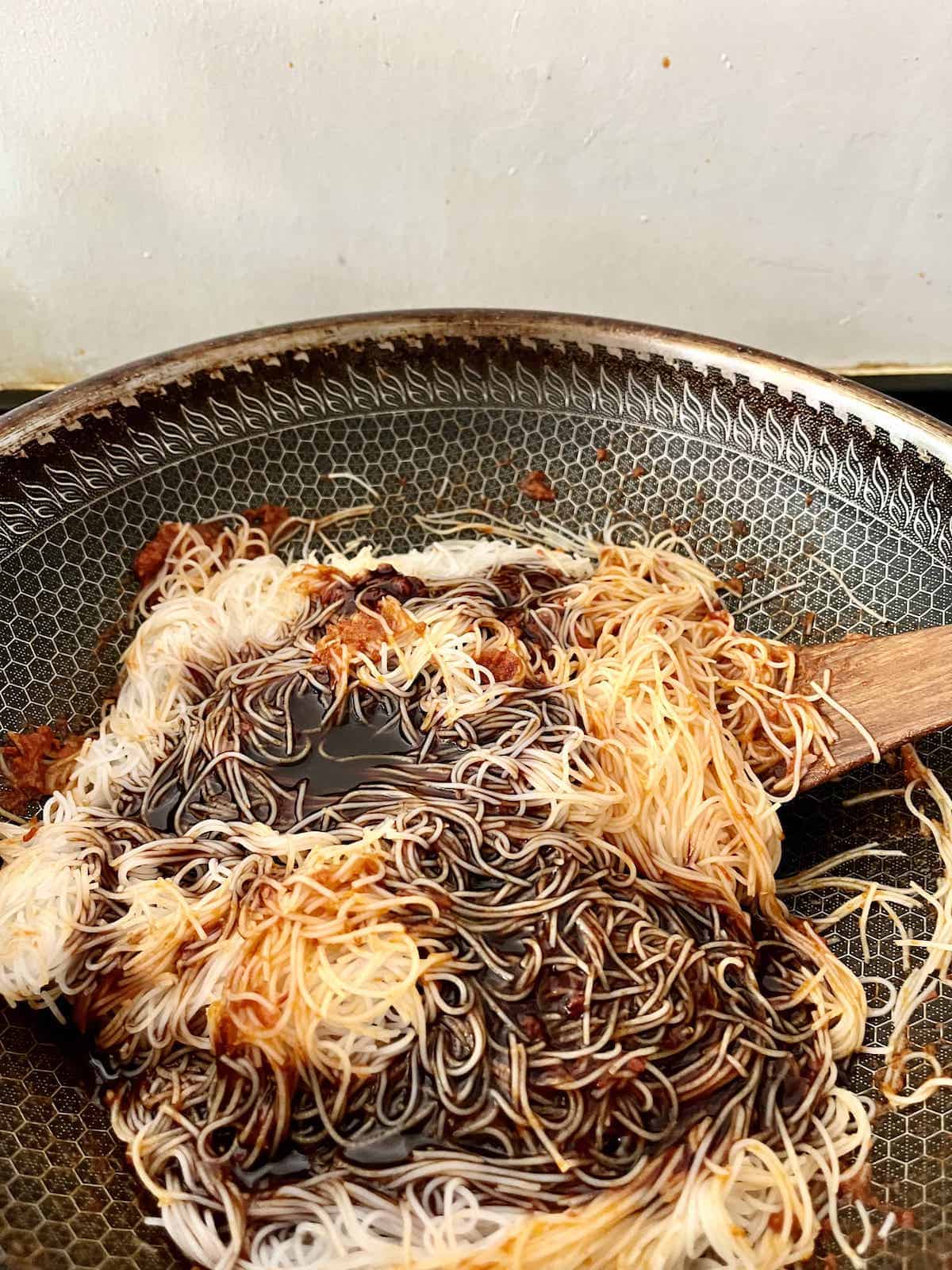
6. Drain the bee hoon well (use a colander) and add to the rempah in the wok.
7. Pour the sauce mixture on top and stir-fry till well mixed.
8. Before serving, add the fried egg slices, cooked julienned carrots, and any other ingredients you're using.
Tip: You know when the noodles have been soaked long enough as the color will change slightly (it'll become opaque) and they'll be pliable.
👩🏻🍳 Expert Tips
Tip #1: You can meal prep by making a big batch of the sauce beforehand, then divide into portions to freeze. The rempah sauce will also last for about 3 days in the fridge.
Tip #2: If adding bean sprouts, make sure they are well-cooked. If not, they'll have a "raw veggies taste" which isn't very nice!
💭 Recipe FAQs
Bihun is different from other types of dried noodles. In Southeast Asia, we're told by our Amahs (grandmothers) not to boil bihun. Instead, we should soak these thin noodles in warm water for 20-30 minutes till soft to touch (though not soggy) then drain. When I compared both methods, there was no difference in the taste of the noodles. It was, however, easier to stir-fry soaked and not blanched bihun as the latter would disintegrate into small pieces.
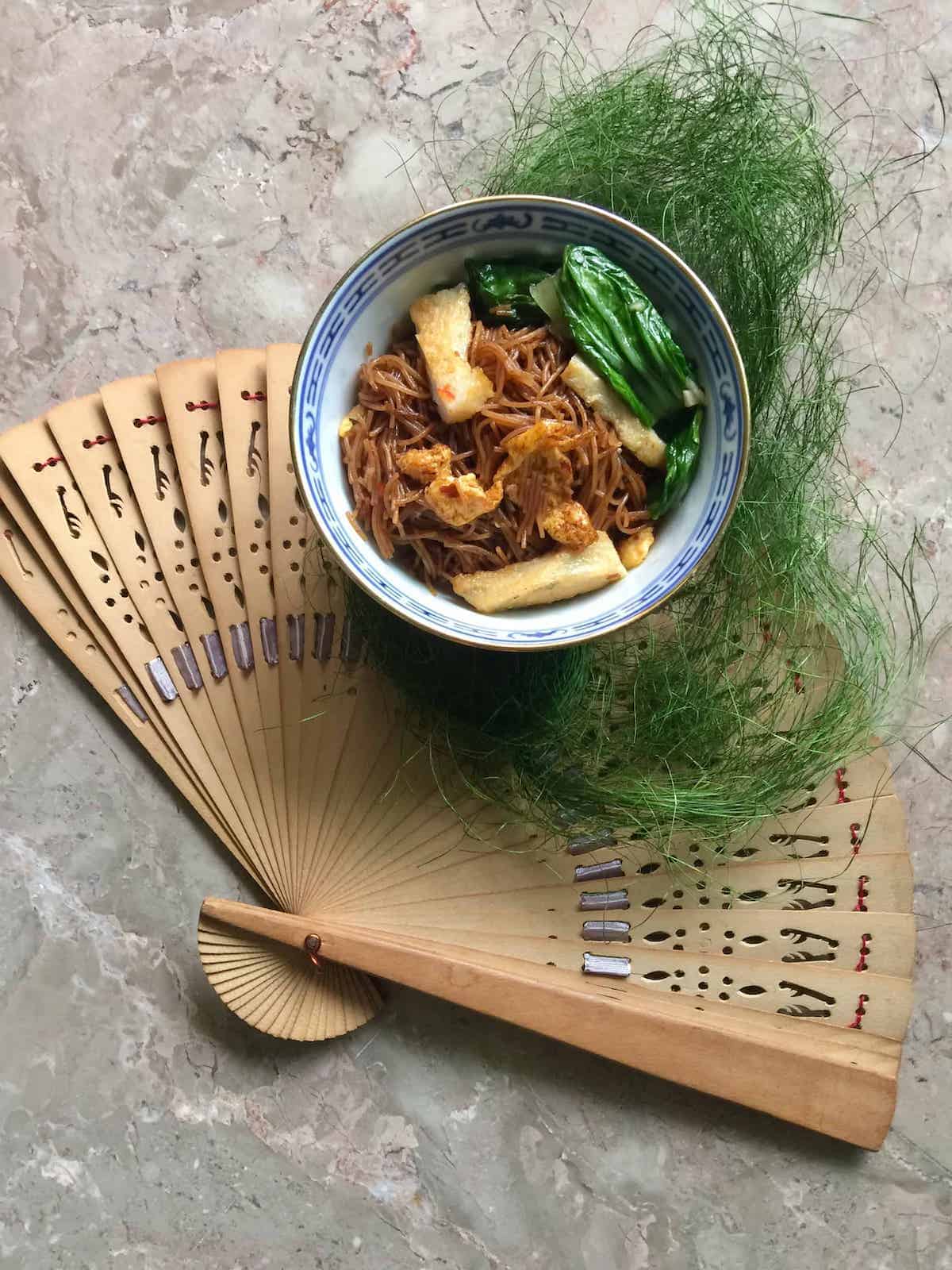
🥬 Suggested Accompanying Recipes
This fried noodle is very flavourful and can be eaten on its own. However, in Asian cooking, more is sometimes more when it comes to flavour, and we like to heap our noodles with Asian side dishes such as:
Enjoyed this easy stir-fried vermicelli recipe? Please leave a 5-star 🌟🌟🌟🌟🌟rating in the recipe card below & if you REALLY like this bihun goreng, a comment would be awesome! Thank you and have a great day!
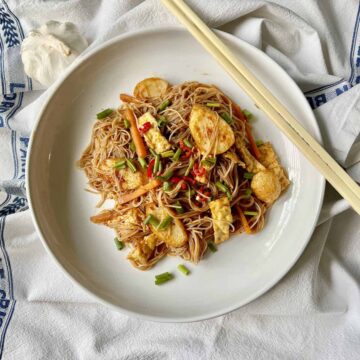
Singapore Fried Vermicelli (Bihun Goreng)
Equipment
- Blender Substitute: mortar and pestle if you have the time!
- Large heatproof bowl to soak the bihun
- Metal sieve To drain the noodles
- Wok Or large pan/ skillet
Ingredients
Rempah
- 4 Dried Chillies, seeds removed Cut into small pieces and seeds removed. Don't rub your eyes after handling chillies or they'll burn!!
- 1 Tablespoon Tamarind Paste Mix well with ½ Cup water then sieve- use the resulting tamarind "juice" for this recipe. If you don't have tamarind on hand, substitute with ½ T rice vinegar. Click here for more info on tamarind.
- 1-3 Fresh red chillies Omit if you don't have any on hand- I often do this as my fresh chilli supply is very intermittent depending on how my balcony plants feel! Alternatively, these are some chili substitutes although note that I've not tested the recipe with them.
- 3 garlic cloves Peeled
- 3 shallots Peeled
Noodles
- ½ lb dry bihun (bee hoon/ mee hoon) (226.8g) Soak in hot water for 20-30 minutes then drain in colander. Don't use cold water to soak. If in a rush, you can blanch the noodles but they'll break easily when frying later.
- Hot water See above
Sauce
- ¼ C kicap manis Substitute with dark soy sauce and a pinch of sugar (preferably gula melaka) if you don't have any kicap manis on hand.
- 4 Tablespoons tomato ketchup (Weirdly enough, if you add more tomato ketchup it makes the noodles spicier!)
- 2 Tablespoons light soy sauce Don't substitute with dark or thick soy sauce. They're not the same thing! You can, however, use fish sauce as an alternative.
- 1 Tablespoon oyster sauce
- Salt, optional You should not need salt after all those saucees but do season to taste if you find it necessary.
For stir-frying
- Pork lard Substitute with vegetable oil if you don't have pork lard on hand (you may need to add a bit more salt in that case as vegetable oil has less flavour) It's easy to render pork lard at home FYI and it keeps for months!
- 1 Asian omelette, cut into strips I used 6 eggs for the omelette, but it's really up to you
- 1 Carrot Peeled and julienned
- 1 fish cake
- 1 teaspoon sesame oil. optional Sesame oil in Chinese cooking is almost always toasted sesame oil. If you don't have it, try 1 of these substitutes for sesame oil.
Optional garnish
- Spring onions, chopped For alternative green garnishes, click here.
- Thinly sliced cucumber
- Pork lardons
Instructions
Preparing the Noodles
- Put the bihun in a heatproof bowl and cover with hot, boiling water for 20-30 minutes. (You can stop soaking once the noodles are flexible, have turned slightly opaque but not soggy. (Whilst it is soaking you can proceed to prepare the rempah, as stated below.) After the 20-30 minutes, drain the bihun.
Making the rempah paste
Frying the Ingredients followed by the Rempah
- Heat a pan on medium-high heat. Add the home rendered pork lard (or vegetable oil) to the hot wok.
- Stir-fry the eggs, then plate and cut into strips. Using the same pan, fry the carrot strips till soft and plate with the eggs. Similarly, pan fry the fish cake slices. Plate.
- Add more oil to the same pan, followed by the blended rempah paste and stir-fry on medium heat in the same wok till it darkens, is fragrant and splits (i.e. the colour of the rempah changes and the oil separates out.) Leave the cooked rempah in the wok.Tip: I'm using a gas stove. Use medium-high heat if using an induction cooker.
Frying and assembling the noodles
- Mix the ingredients for the sauce together then leave beside your cooker.
- Add the drained bihun to the wok with the rempah, stir, then add the sauce ingredients. Stir fry till well-mixed, add the omelette, carrots and fish cake, stir a few times then switch off the fire.
- Drizzle the sesame oil over the noodles and serve.
Notes
Note: the nutritional information is an estimate automatically calculated using the WPRM recipe maker and I am not responsible for its veracity.
Nutrition
If you've enjoyed this fried vermicelli recipe, would you like to sign up for my Asian recipes' newsletter?

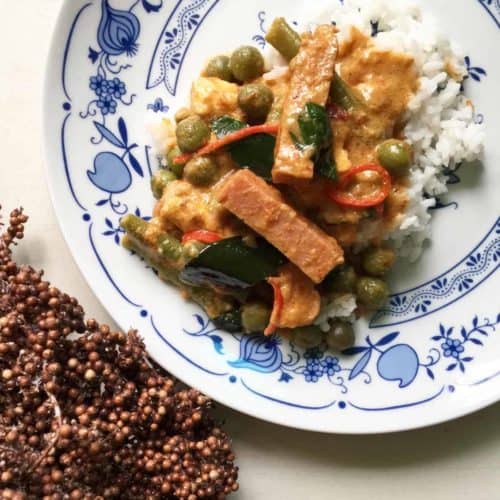
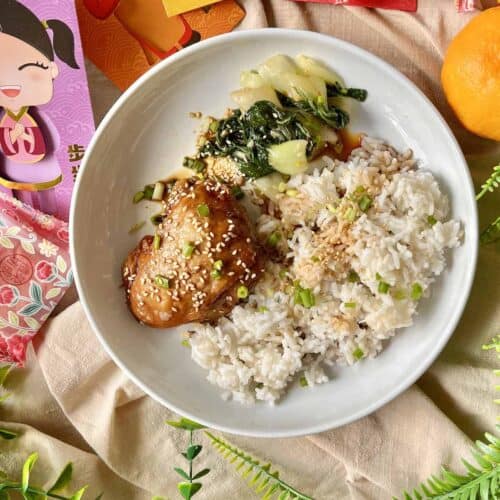
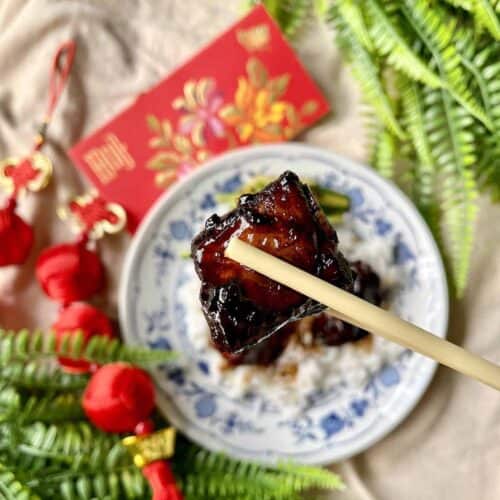
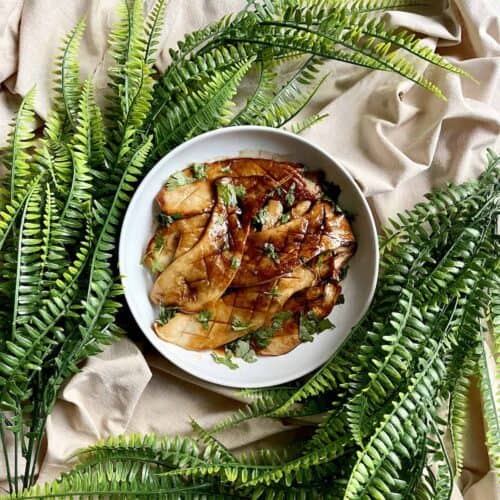
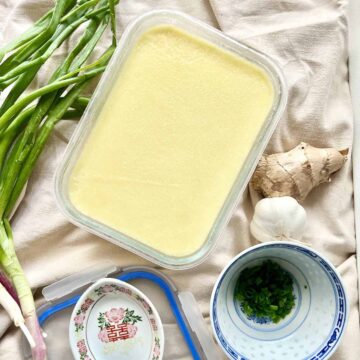
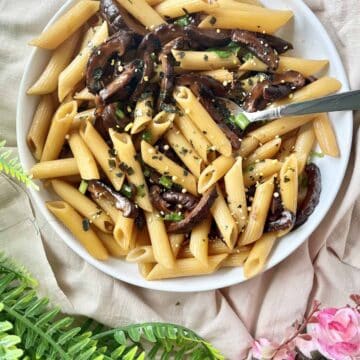
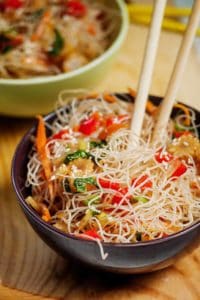
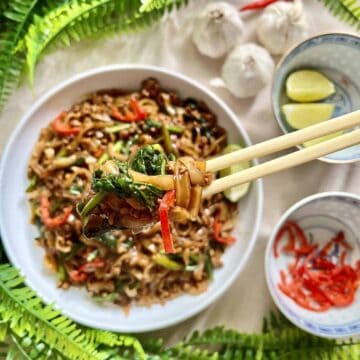
Fen says
Gosh never thought of adding tamarind to noodles. This was so good!
Zen says
Happy to have introduced a new noodle ingredient, Fen. Hopefully you'll make this bihun goreng often!